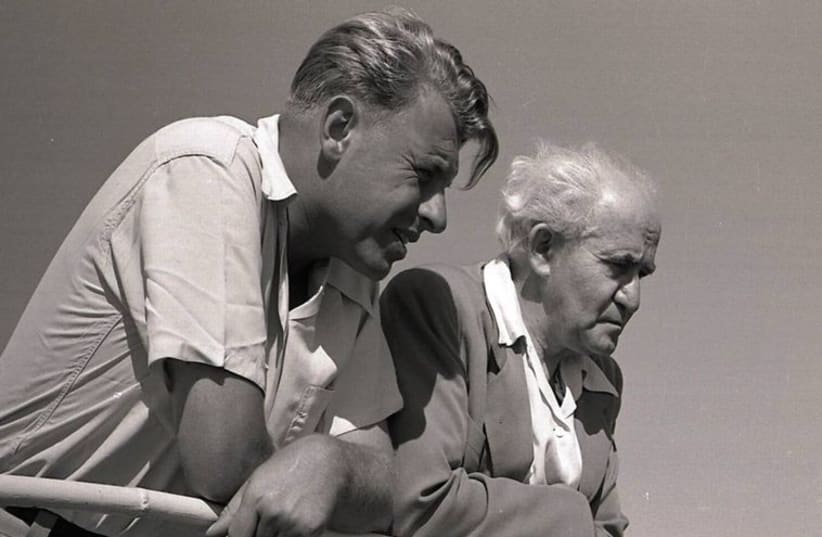See the latest opinion pieces on our page
From the style one sees an elegance of writing, and a mind capable of independent thought. In another exchange, the correspondent wrote, “I watch the news, very occasionally, and there are always haredim [ultra-Orthodox Jews] throwing diapers at the police, or people getting stabbed by ‘Palestinians,’ or things blowing up, or Molotov cocktails and rocks...”I wrote, “I happen to love Jerusalem, the stone and the light. It will not be divided, because it already is. We have many problems called unhappy haredim and unhappy Arabs under our rule, (who would probably choose to stay if they ever got the choice).”Well, I am of course a romantic. As a young (very young) adult in North America, I dreamt of life in the kibbutz. Once I realized that kibbutz life seemed too bucolic and limiting, as a matter of course, my eyes followed my heart to Jerusalem. The British ruler had ordained the use of stone for our buildings, for which we tip our hat to Sir Ronald Storrs, the first military governor of the city, almost a hundred years ago.To me, every footstep here was a heartbeat of joy and gratified happiness.A small town, a struggling town, striving to find its soul and center since a visible and invisible wall divided the Old City and east Jerusalem from the New City. I can’t recall Jerusalemites being smug. The people I met were young newspapermen, university students, Israel Radio editors and reporters, and eventually various cabinet ministers, senior officials and men such as Teddy Kollek and diplomat and academic administrator Avraham Harman. They/we were all involved in building the country or criticizing how the country was being built.But we all knew that we were creating something historic, lasting, exciting.I was a new immigrant, never condescended to, always helped and made welcome.The few smug Israelis I met were the young graduates of Prof. Don Patinkin’s Chicago-influenced economics courses at the Hebrew University. These were staffing the Finance Ministry and knew the answers to everything. A few of course had warm Jewish hearts, and understood that behind the ugly statistics were real human beings.When Kollek became mayor, he created a large circle of world-famous architects and town planners who helped create a blueprint for the future. He began to make the city an international landmark, with a first-class museum and preservation of much of the older buildings, and the renewal and revitalization of decrepit neighborhoods. Flower-lined boulevards, parks, community centers, all were built in concert with the Jerusalem Foundation which Teddy founded.The few non-stone buildings in neighborhoods such as Talpiot or Beit Hakerem (which were not part of the tiny Jerusalem of Storrs, and hence not built with stone), sprouted – in stone – and grew and coalesced into an urban mass.Kollek was mayor from 1965 to 1993. His successors are better not mentioned until Nir Barkat became mayor in 2008. He has improved on Kollek’s initiative, and wisely has sought to prevent conflict with the haredim. After 1967’s Six Day War, in addition to the Old City, major all-Arab neighborhoods were incorporated into the city limits. But the municipal budget for improving service and infrastructure standards in the Arab areas has not been granted the major funding needed from the national budget to create a better-functioning, up-to-date infrastructure.That’s why I said the city is de facto divided.The modern city in some ways, in spite of some fine building in the Arab neighborhoods, stops along the lines of the Six Day War. Furthermore, the rhythm of daily life in east Jerusalem is governed by the Islamic calendar: Arabic is the language spoken by the inhabitants, and the signs are rarely in Hebrew, even in part. On Simhat Torah, on A-Zahara street in east Jerusalem I asked a resident: “Everything is open here – all the stores... how come, it’s a holiday today.”“That’s in Israel. Here everything is open.”Jerusalem is a beautiful metropolis, full of life, contrasts and parks, tree-lined streets and flowery boulevards. Remember, television news is too often rating-centered searching for the “newsworthy.” So there is a haredi demonstration, and a diaper is thrown. Knifings and stone-throwing are so far between that – as I told my late mother years ago – I am safer in Jerusalem than in most cities in the West.TV does not portray the powerful intellectual, artistic, cultural pulses of a city dominated by a great university, outstanding hospitals, government ministries and varying streams of Orthodoxy and tradition.A city whose haredi neighbors swamp my area in their seasonal yeshiva breaks. A city where Arab neighbors flock to the fountains and parks which are open to all.In truth, I am almost offended and sad that you do not come and spend days here. There is so much to do and so much to see. Jerusalem is beautiful. Jerusalem creates itself anew every day. I not only invite you to Jerusalem, I will be glad to meet you here. Drinks on me.Here, in Jerusalem. My favorite city.The writer has been a Jerusalem resident for 62 years, and experienced part of the state and city building in his various senior roles in government and the Jewish Agency as well as at the Hebrew University of Jerusalem.2avrahams@gmail.com
The POSTman Knocks Twice: Jerusalem, loved – Jerusalem, unloved
I think that all of us are exhausted by the simatokha in the media about the election, the Netanyahu Washington speech, and the mud-wrestling of too many of our politicians.
